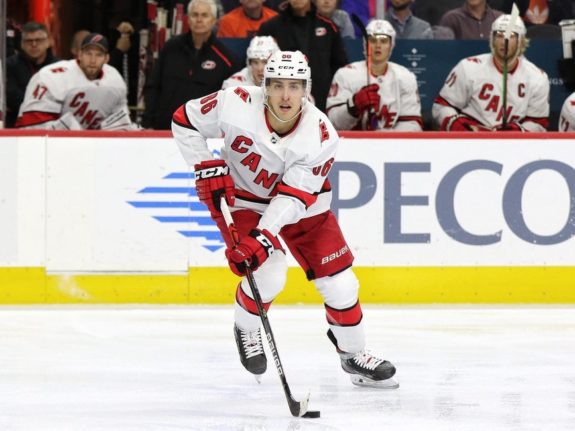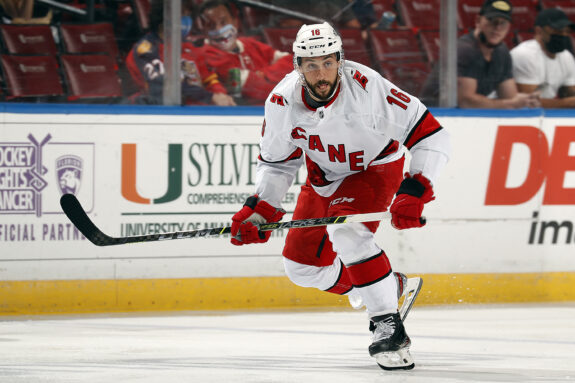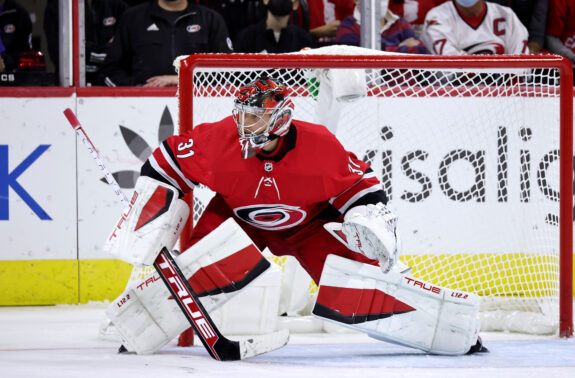As the NHL playoffs creep closer to the horizon, the Carolina Hurricanes are looking to make a push for the Stanley Cup. However, many questions need to be answered since they have a lot of doubters heading into May. Some Hurricanes players will need to produce at a high level in the postseason if the Hurricanes want to be successful. Here are three players who must play to the best of their abilities to ensure a deep playoff run.
Teuvo Teravainen
Teravainen has been one of the top performers on the team since he came over from the Chicago Blackhawks in 2016. Since he was traded, he has the second-most goals, the most assists, and points on the team. The young Finnish forward has been fantastic in the regular season, but when it comes to the playoffs, there could be some improvements. In 34 postseason games, Teravainen, with his $5.4 million cap hit, has 12 goals and 21 points for a .617 points-per-game (P/G) average.

For comparison, other wingers on similar contracts have produced better numbers in the playoffs:
- TJ Oshie ($5.75M) – 41 games, 13 goals, 30 points, (.731 P/G)
- Jordan Eberle ($5.5M) – 49 games, 13 goals, 34 points, (.694 P/G)
- Josh Bailey ($5M) – 41 games, 8 goals, 33 points (.805 P/G)
While 21 points in 34 playoff games isn’t horrible, fans may want more from the man who is worth almost $5.5 million of the HUrricanes’ payroll. Sebastian Aho (35 points in 34 playoff games) and Andrei Svechnikov (20 points in 26 playoff games) have both recorded points consistently, which would lead one to believe that Teravainen would have better numbers. A Teravainen breakout in the playoffs is just what this team needs to make a deep run.
Vincent Trocheck
Vincent Trocheck is another great regular-season performer who hasn’t quite found his stride in the playoffs. He’s been a solid center for the Hurricanes since he was traded from the Florida Panthers in 2020. Through 131 games in Carolina, he has 38 goals and 93 points. Those are respectable numbers, but his stats take a huge dip in the playoffs. In his postseason career, the Pittsburgh native has just two goals and six points in 19 games. His numbers don’t translate well compared to the reputation he’s made for himself in the regular season.

Last season, Trocheck finished second on the team in points (43) and third in goals (17), so his lackluster scoring prowess in the postseason has raised some eyebrows. Martin Necas, Brett Pesce, and Brock McGinn all outscored the veteran in 2020-21, while Aho, the points leader that postseason, scored four more times with eight more points for Carolina. With Trocheck hitting his stride at the right time, the Canes could be a force to be reckoned with from late April until June.
Frederik Andersen
Unlike the other two, Andersen has a history of playoff success. In seven seasons of postseason starts, the Danish netminder has a 27-23 record with a .916 save percentage (SV%), 2.55 goals-against average (GAA), and three shutouts. Those numbers are respectable, but in his last two playoff stints, he has a .928 SV% and 2.35 GAA. To put it bluntly, Andersen has been elite in the playoffs recently, and that’s why the Hurricanes signed him to a two-year, $9 million contract back in July.

Now begs the question: Why is Andersen on this list if he’s been so good?
The reason is simple: uncertainty. The 6-foot-4 goaltender recently sustained an injury in a loss to the Colorado Avalanche. Though his MRI came back negative, head coach Rod Brind’Amour said on April 18 that he’ll be re-evaluated in a week. With only two regular-season games remaining since then, the Hurricanes will have to hope that he’s 100 percent for the playoffs. If not, then the team will either have to rely on Antti Raanta, who has just five games of playoff experience with an 0-1 record, .846 SV%, and 3.59 GAA, or they’ll roll with an injured Andersen. Neither option is ideal, but if it were up to the Hurricanes, they’d likely choose Andersen at 80 percent than Raanta at 100 percent.
If Andersen starts in Game 1, there’s no guarantee that he will be at his best. Recovering from an injury is never easy, and there’s no way to know if he’ll be the same Vezina-caliber goaltender that he’s been all season with a lower-body injury. That being said, teams typically live and die by their goalie, which is why Andersen is likely to play his heart out for every minute that he’s in net.